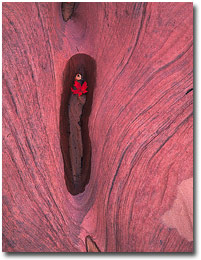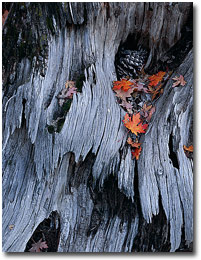Intimate LandcapesText and Photography Copyright Guy Tal. All rights reserved.
The term Intimate Landscapes is attributed to Eliot Porter, a pioneer of color landscape photography. You will likely find mentions of it in a wide variety of articles and books by any number of notable photographers, yet most are careful not to accurately define the term, and rightly so. Intimacy implies an emotional and personal context that any one of us may (and should) interpret and apply individually.


Thumbnails are links to full size images.
|
|
To me an Intimate Landscape is one that falls between grand scenics, drawing their power from sheer enormity and majesty of a subject, and extreme close-ups, relying on magnification of a subject, evoking interest from the mere fact that these sights are not often possible with or apparent to the naked eye. The Intimate Landscape does not rely on interesting subjects or optical effects alone – it encompasses a relatively small number of elements and draws its power from composition - the arrangement of the various elements relative to each other and to the frame boundaries. Intimate Landscapes do not dictate subject scale, or specific perspectives or focal lengths. Like a floral arrangement or a haiku it relies on establishing structure and order and ulterior meaning from an arrangement of elements – a whole that is greater than the sum of its parts. As such, Intimate Landscapes provide a fine-art photographer with great freedom to express his or her vision. The image does not rely on any prominent landmark or any one particularly interesting element. It's about the deliberate thought and insight of putting the elements together in that particular arrangement.
The Intimate Landscape relies on vision, rather than opportunity.
Intimacy is what makes such an image powerful – the photographer must experience and capture a scene in such a way as to place the viewer right there beside them, distilling and amplifying that which caught their eye and flared their creativity and made them want to capture and share it.
Intimacy can be achieved in a number of ways. One already mentioned is to simplify - reducing the image to as few elements as absolutely necessary, distilling the essence of what you, the artist, find most powerful about a scene. This can be an object, a line, a pattern, combination of colors, etc.
Next is avoiding the temptation to rely on "special effects", whether it's the distortion of a wide lens, the extreme magnification of a macro, or over-the-top digital enhancements. These are all good ways of generating impact, but not necessarily intimacy. Intimacy should rely primarily on vision, not technique, on communicating to the viewer what it was the photographer him/herself was moved by when they came upon the scene.
Limiting the frame to scenes that do not include the sky, and in general excluding large prominent elements is another useful consideration - keep the viewer focused, rather than wandering around the frame.
In an age of over-photographed icons, and an abundance of technically excellent yet repetitive portrayals of similar scenes and subjects, Intimate Landscapes are the photo-artist's opportunity to express original vision, to explore new ground, and to include more of him or herself in the image.
Editor's note - View more of Guy's work on his website at http://scenicwild.com.
GT-NPN 0440
Comments on NPN landscape photography articles? Send them to the editor.


| 


